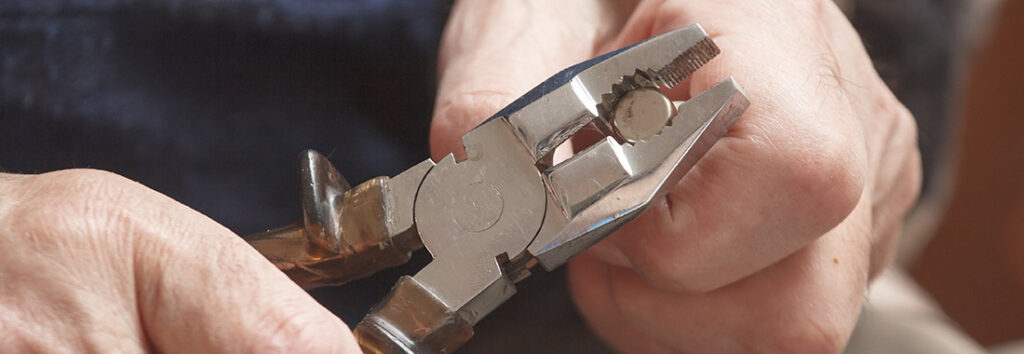

Pliers and pincers are among the most versatile and important hand tools for a wide range of DIY, electrical and carpentry tasks. In this guide, we’ll be taking a look at the tool’s anatomy and the various different types of pincers and pliers available.
What are pliers?
Available in a wide variety of shapes and sizes, all pliers are built with the same basic fundamentals. This incorporates two pieces of hard-wearing material joined to create a pivot, with handles at one end of the tool and jaws at the other.
The vast majority of pliers comprise the same six basic parts:
- Handles
- Pivot point
- Jaws
- Cutters
- Pipe grip
- Tip
What are pliers used for?
The basic purpose is to grip something exponentially more tightly and securely than would otherwise be possible. This enables the user to twist, bend, pull, shear or cut a wide variety of materials and objects with relative ease.
Pliers can be used for an extensive range of purposes – anything from loosening nuts and bolts to cutting through cables and bending thick wires into shape.
Different types of pliers
Most pliers are designed with specific uses in mind, though it is also possible to use one pair for a wide variety of different applications. We’ll now take a look at some of the most common types of plier available and their primary purposes:
Combination
Combination pliers are among the most versatile types of pliers available. A staple in the majority of toolboxes, combination pincers are true multipurpose tools that can be used for all sorts of jobs. Examples of which include stripping and bending wires, loosening and tightening bolts, cutting cables and more. All from an affordable, robust and reliable hand tool.
Cutters
This is a category of plier designed primarily with cutting in mind. Fitted with strong and sharp blades, cutters are not appropriate for gripping, but for cutting through a variety of materials with relative ease. Common types of cutter pliers include diagonal cutters, end cutters and wire snippers. This also includes bolt cutters, which can be used to cut through solid metal bars and much thicker cables.
Flat nose
Widely used by electricians and jewellers, flat nose pliers can be extremely handy when tackling delicate and precise jobs. They have much longer and thinner jaws than conventional models with comparatively short handles. This enables items and components to be gripped and manipulated in a more precise way.
Locking
This is a specialist type of tool that enables the user to ‘lock’ the grip in place using a special mechanism, which then retains the gripping force without pressure from the user. Locking pliers are an absolute must in plumbing, carpentry and automotive environments. They often featuring an adjustable jaw that can be widened or narrowed by turning a screw.
Long nose
Long nose pliers are predominantly similar to the flat nose variety. They feature elongated jaws, shorter handles and a slimmer profile. This makes them perfect for getting into tricky places and handling objects with greater precision. These are are often referred to as needle nose, pinch nose and snipe nose pliers.
Pincers
Pincers differ from conventional pliers in that they concentrate the energy exerted on the tool to a much sharper point. This enables them to pinch or cut through a variety of materials. They’re also ideal for difficult extraction tasks (like pulling nails out of wood) due to the additional leverage their shape provides.
How to choose the right pliers
Choosing the right pliers is primarily a case of establishing your requirements and ensuring you a tool suitable for your job. There are several additional considerations to factor in before placing your order, which include the following:
- The general quality and durability of the pliers, particularly those to be used for heavy duty applications
- The comfort, grip and safety of the handles, which varies significantly from one product to the next
- Whether the tool is suitable for your requirements – i.e. safe for electrical work, use in wet working conditions etc
- Any warranties provided by the manufacturer to cover your purchase
Above all else, stick with a reputable manufacturer you can count on.



